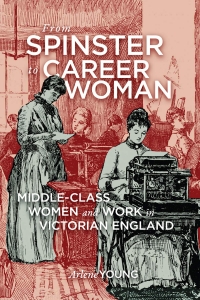In From Spinster to Career Woman: Middle-Class Women and Work in Victorian England, Arlene Young explores changing perceptions of women’s work in mid-Victorian England and the lingering anxieties surrounding the growing cultural acceptance of the figure of the middle-class working woman. This book offers a fresh perspective on the Victorian period and will be a welcome addition to the bookshelves of anyone interested in women’s history, British history and labour studies, recommends Katelan Dunn.
From Spinster to Career Woman: Middle-Class Women and Work in Victorian England. Arlene Young. McGill-Queen’s University Press. 2019.
 Find this book (affiliate link):
Find this book (affiliate link): ![]()
Spinster: ‘an unmarried woman and especially one past the common age for marrying’.
In From Spinster to Career Woman, Arlene Young takes us on a fascinating, complex and radical journey exploring women’s work in mid-Victorian England. Young examines cultural perceptions of women at the time, as dictated by Victorian ideals of womanhood, alongside representations of women’s work, anxieties over the disproportionate ratio of eligible (and marriageable) women and men in the period as well as women’s desire for personal and financial freedom.
In mid-Victorian England, custom and tradition dictated female dependence, with assumptions about a woman’s ‘nature’ deeply entrenched in society. However, the demographic reality of a skewed male-to-female ratio in mid-nineteenth-century Victorian England ‘presented a challenge to the values and assumptions of the nation’:
The lack of husbands presented special difficulties for woman of the middle classes, women who were not raised to work, who had neither the education nor training for work, and whose family fortunes were not extensive enough to provide life-long support for unemployed spinsters (18).
The realisation that women would need jobs to support themselves opened space in the social framework for ideas challenging the relationship between dependency and femininity, and the separation of public and private spheres. As a result, debates ‘shifted from […] speculations about what could, or should, or would happen if middle-class women were to be admitted to the ranks of the educated, the trained, and the gainfully employed to more practical considerations of the kinds of work in which women were actually engaging’ (25-26).
The recognition that women needed work wasn’t enough to transform Victorian ideals of femininity and motherhood completely. Those who positioned themselves within the educational and employment debates were ambivalent. In Chapter One, Young describes how on the one hand, opponents argued that a woman’s place was in the home and her innate purpose was to be a wife, with educational and employment opportunities undermining the most natural of female roles ordained to women by Nature: that of motherhood. On the other hand, proponents demonstrated a more enlightened position, advocating for the necessity of education and employment opportunities as a basis for the full development of a woman’s moral and intellectual character, private happiness and personal fulfillment. Others, still, argued that an education was necessary because ‘a better education […will] fit them to do their duty’ (23). In other words, this ‘call for more opportunities becomes an argument not for educating women for new roles in society but for educating them to a becoming appreciation of the status quo’ (23), with education and employment helping women to hone the skills required of good mothers and useful wives.
Young states that occupations deemed respectable, professional and steady during this time included nursing and teaching, both of which ‘represented work that conformed to Victorian ideals of femininity: caring for the sick and teaching children’ (27) and were regarded as both honoured and honourable. While middle-class women in the nursing profession, for example, demonstrated a specialised degree of knowledge, their work was seen as an extension of domesticity rather than a challenge to the status quo. Therefore, public recognition and representations of nursing in Victorian fiction, in periodical presses and in mainstream media were largely based on nursing as charity and philanthropy rather than skilled work.
 Image Credit: ‘An army nurse. Watercolour drawing’. Wellcome Collection. Attribution 4.0 International (CC BY 4.0)
Image Credit: ‘An army nurse. Watercolour drawing’. Wellcome Collection. Attribution 4.0 International (CC BY 4.0)
However, Young argues that the cultural acceptance of middle-class working women arose when prominent publications for upper-middle-class ladies began adding articles on women’s work, with contributors recasting and redefining what it means to be a woman. Here we see writer Frances Martin’s notion of the ‘Glorified Spinster’ (an independent, vibrant, confident, career woman), George Whyte-Melville’s figure of the ‘Strong Minded Woman’ and the cultural icons of Mary Carpenter, Sister Dora and Florence Nightingale: all of these helped to reinforce and solidify nursing as ‘the vanguard of professionalized work for Victorian women’ (38) and as models of self-sacrifice and philanthropy, both Victorian ideals of womanhood. Important to note here is the interconnection between work and the class system, creating a dichotomy between educated middle-class women accustomed to affluence and leisure and those occupying the lower echelons of the class system, relegated to domestic servant work requiring physical exertion. This class division further reinforced ideals of the refined, cultured, cultivated woman and the kind of remunerative work being done.
In Chapter Two, we read about the difficult trajectory ‘of the lady nurse from selfless volunteer to trained and efficient professional’ (39), including antagonistic working relations between doctors and lady nurses, reforms in hospital management and professional hierarchies. Furthermore, Young touches on how cultural stereotypes, like Charles Dickens’s disreputable Sairey Gamp in Martin Chuzzlewit (1843-44) and the Strong-Minded Woman, were invoked to dismiss nurses’ educational attainment and professional training and undermine their credibility. These brought the ‘nursing question’ to the forefront of public consciousness and established the nursing debate (should they or shouldn’t they?) as a pressing public issue. Also notable is the marginalisation of men from nursing to such an extent that they were excluded entirely from the College of Nursing (established in 1916), typically only working in military hospitals and asylums. Here, we begin to see nursing transition from an exclusively male field to almost solely feminine.
Gender and class ideologies were further reinforced during this time by Victorian fiction. Many novels transition from ideals of womanhood and motherhood to centring on the heroic struggle confronting women to define themselves as educated, civically engaged, working members of the economy ‘within a culture that preferred to limit them to the domestic realm’ (60). One powerful piece of Victorian fiction that Young discusses is Elizabeth Gaskell’s Ruth (1853). This novel mirrors the cultural anxieties at the time and the paradox of Victorian conventions dictating behaviour, dress and moral character and the emerging need for women to financially support themselves. Despite Ruth having to work, she redeems herself by the work she participates in (sewing, deemed domestic and ladylike, and governessing, deemed respectable), while also exhibiting Victorian ideals of femininity: beauty, modesty, obedience, respectfulness, innocence and selflessness.
Young further explores the significance of types of work in Chapter Four with respect to the typewriter. Here we see the same sort of cultural discomfort with the typist as with the lady nurse. However, ‘the typewriter presented very different representational problems […] Unlike the figure of the middle-class nurse, she did not carry the baggage of preconceived notions from earlier incarnations; there were no images of Sairey Gamps to overcome’ (125). The typewriter offered both the promise and threat of independence; while nursing was attached to both professionalism and caregiving, the womanliness of the typist was in question due to ‘the idea of attractive, accomplished, and marriageable young women working in close proximity to men’ (126). Using a plethora of examples of fictional portrayals of typists in Victorian fiction, Young shows how representations were predominantly negative. She highlights the characterisation of typists as lonely, vulgar and unwomanly, while the typewriter itself was defeminised, being described as aesthetically unpleasing, masculine, loud and disruptive. Not only was the typewriter regarded as a threat to the potential of a competent professional woman, but it is also represented as a vehicle for women to reach both a higher level of independence and to postpone or completely eschew marriage.
Young concludes her book with the question that weighed heavy on the public’s consciousness at the time: what shall we do with our daughters? This presents us with both ‘the sense of patriarchal concern and proprietary claim regarding ‘‘our’’ daughters’ (164), but also the stark reality that women during this time remained ‘caught between professionalism and womanlinessness’ (157): woman were regarded as ‘either too professional to be feminine or too feminine to be professional’ (157). There was no secure or clear identity for women to adopt. Yet, as Young writes: ‘In 1860, the answer to the question ‘‘what is to be done with our girls?’’ would have been to find her a suitable husband. By the 1890s, the answer was the one that forward thinkers had been insisting on for decades: educate her for employment’ (169).
One might argue that the occupational status of the professions highlighted in Young’s book (nursing, teaching and typing) remain heavily female-dominated in the twenty-first century. Women on average receive less pay and less occupational prestige than their male counterparts. The ‘glass ceiling’ still presents barriers to women’s advancement to the upper echelons of management, and women are still more likely to perform what Arlie Hochschild describes as a double day: juggling the demands of work and domestic responsibilities. The term ‘spinster’ is also still very much in the public consciousness, with its male equivalent, ‘bachelor’, carrying less pejorative connotations. In an excerpt from the 2014 article ‘Don’t Call Me A Spinster’, Claudia Connell writes:
When it comes to the spinster, society just can’t seem to make its peace with us. The stereotypical image of long ago of the oddball woman in the village who makes people feel a bit uncomfortable still sticks. The notion of the happy, unattached female is a myth as far as most are concerned.
While collectively we have recognised the need for greater and equal opportunities in education and employment for women, we still idealise outdated models of what it means to be a woman. While cultural tensions are obviously less strained than they once were in Victorian England, they persist in other ways.
Arlene Young’s book provides a fresh and new perspective on the Victorian period. From Spinster to Career Woman would be a welcome addition to the bookshelves of anyone interested in women’s history, British history, labour studies and women’s studies.
Note: This review gives the views of the author, and not the position of the LSE Review of Books blog, or of the London School of Economics. The LSE RB blog may receive a small commission if you choose to make a purchase through the above Amazon affiliate link. This is entirely independent of the coverage of the book on LSE Review of Books.







